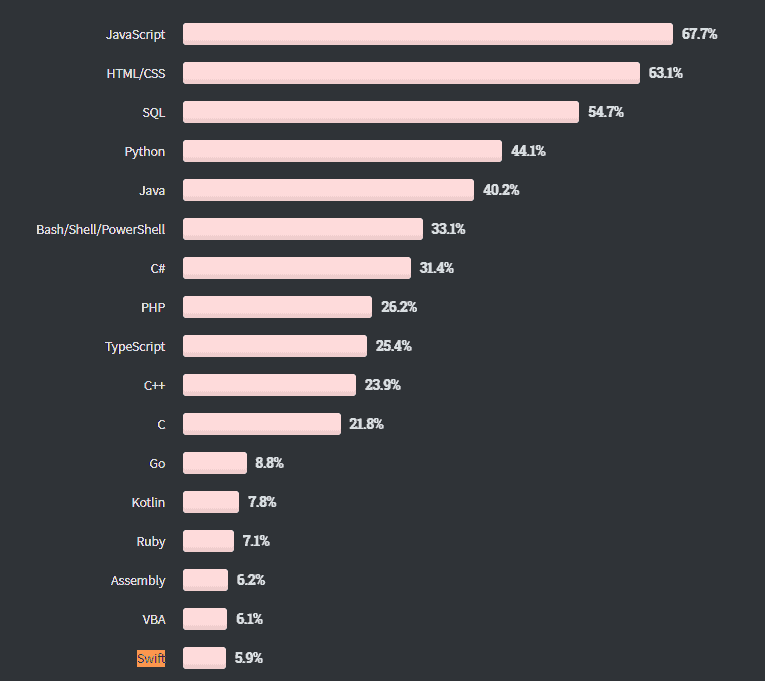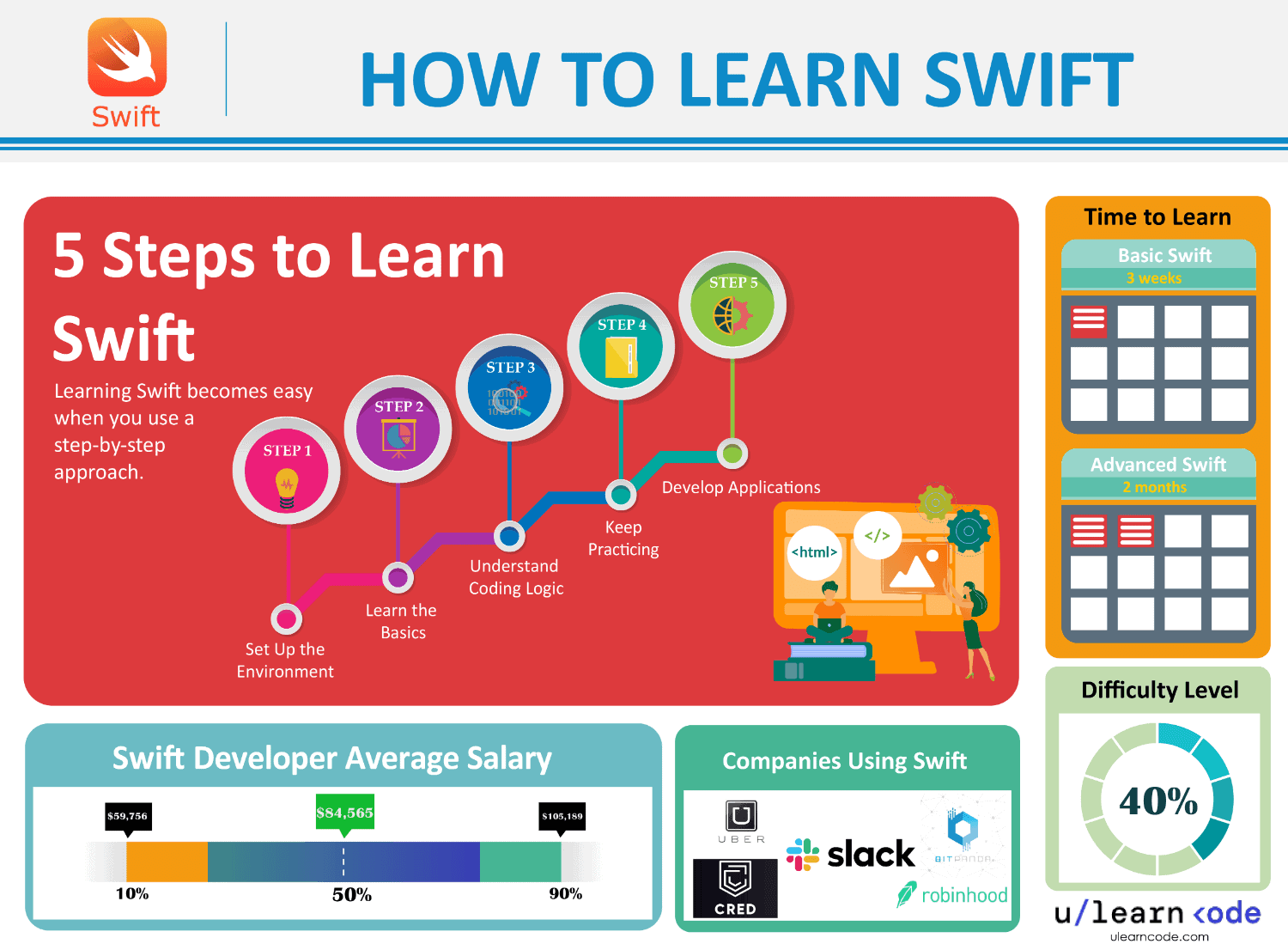Contents
Until 2014, Apple Inc. was heavily reliant on Objective-C for their macOS and iOS development. All major platforms of Apple, including popular applications, used Objective-C in one way or the other.
This programming language lacked speedy execution and good security, so Apple felt the need for a better alternative, which was fulfilled by Swift. Apple officially released their general-purpose and multi-paradigm language back in 2014.
Swift serves multiple purposes, but its main applications are in iOS, macOS, WatchOS, and tvOS development. Due to its relatively simple syntax, Swift is considered a modern language.

The StackOverflow Insights listed Swift as the 17th most popular programming language of 2020. Its popularity is naturally limited since the core focus of Swift is for Apple’s platforms. Moreover, being newer, it may take over 10 years to climb the top ten languages list.
There is a lot of room for new developers, as the language itself is just 7 years old, and it’s growing more mature with every passing year. Therefore, it is a great time to learn Swift.
Is Swift Easy to Learn?
The Apple developers made Swift easy for programmers from all backgrounds, whether they are beginners or professionals in other languages. The language itself is counted as a modern one, and it is known for its simple and understandable syntax.
Swift coding is very interactive and fun. Unlike other languages, you do not have to write a thousand blocks of code to develop a simple application. There are many added features that aid the developers to make coding more fun.
There are some advanced concepts included in the language but they are also learnable if you have a firm grip over its basics. Moreover, if you have any prior programming experience with Java or Objective-C then you will definitely find Swift to be easier.
How Long Does it Take to Learn Swift?
Swift is not very extensive; hence, you can easily cover all of its basics in around 3 weeks. This time period can be significantly decreased if you are giving over 4 hours daily. However, expert programmers tend to learn Swift in less than a week.
If you are a beginner in programming, then the learning period will be entirely different for you. How quickly you pick up these concepts depends on your intellectual level and programming foundation. Before you move onto learning your first language, it’s recommended to learn the basics of programming.
Once you learn those basic concepts, then you will need time to practice them for developing something useful using iOS SDK or any other Swift framework.
It usually takes over 10 months or a year to develop your first professional application with Swift, provided you are constantly making efforts.
This time period can also vary among frameworks. Simply form a strong grip on any of its frameworks and stick to it until you have enough expertise to develop a concept-based application.
Best Way to Learn Swift

If you have decided to learn Swift for pursuing your career, then here are five simple steps that will keep you on the right track once you start your journey.
#1: Set Up the Environment
Every programming language demands a particular environment where developers can easily code with their full potential. Xcode offers you just such an environment that is used for Swift to code applications.
The Xcode consists of a code editor compiler, debugger, and a project organizer along with additional tools to help you during the development process.
The majority of Swift developers use Xcode to develop iOS applications. However, you also need a Mac computer to use this IDE. If you do not have a Mac device, then you won’t be able to run Xcode, which is a huge downside for such an environment.
#2: Learn the Basics
Every beginner starts with basic concepts that make it easier to understand advanced ones later. Swift is a modern language that Apple developed by keeping beginners in focus, and the syntax is kept simple so that everyone can learn its basics.
There are numerous impressive Swift courses available if you want to learn it the easy way. These courses take you from a basic to an advanced level where you learn about new frameworks. Moreover, here are some free sources where you can clear up your basic awarness:
- Swift Tutorial – Full Course for Beginners
- Swift 5 Complete Tutorial
- Swift Tutorial For Beginners [5 Hour Course]
#3: Understand Coding Logic
Swift code is the root of application functioning. There is a logic behind every functionality you tend to insert in your app. When starting from scratch, you need to understand both the code and the logic behind this code to efficiently develop a program.
#4: Keep Practicing
Once you have basic concepts in your mind, then it’s time to explore more about the language. Try writing code for different applications that are backed by logic. Explore Swift Forums and interact with other Swift developers.
The community can really help you grow fast, and you can ask questions of Swift experts to gain valuable experience. Check how other people are writing their codes and how they are utilizing logic.
#5: Develop Applications
Your journey doesn’t end after learning the basics. There are generally three phases to learn any programming language:
- Learning Phase
- Practice Phase
- Experience Phase
Once you are done with the fundamentals and have been practicing the concepts for a few months, then it’s time to gain experience. Stop watching tutorials and start your own project with a simple idea. Start by designing your app features, then move to its data structure.
The next step is to see which libraries and frameworks you need to utilize. Once your environment is set up, then try to code the decided features one by one. Make multiple sample applications before you apply for any job.
In Summary
Swift is the ideal language for almost all of Apple’s platforms and it has the potential to grow exponentially in upcoming years.
Swift is also expanding with its new implementations in different fields, including machine learning. Hence, it is a great option for beginners who are more focused on learning iOS development.